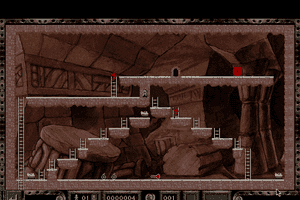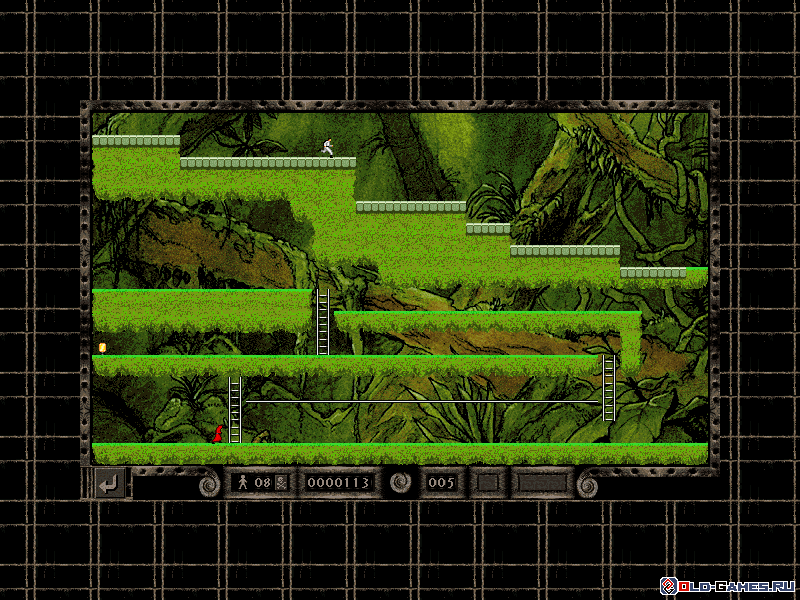| Lode Runner: The Legend Returns | |
|---|---|
| Developer(s) | Presage Software |
| Publisher(s) | Sierra Online |
| Designer(s) | Jake Hoelter |
| Platform(s) | MS-DOS, Mac OS, PlayStation, Saturn, Windows |
| Release | 1994 |
| Genre(s) | Platform, Puzzle |
| Mode(s) | Single-player, Multiplayer |
Lode Runner: The Legend Returns is a 1994 remake of the classic Lode Runnervideo game. It was released for Microsoft Windows, Mac OS, Sega Saturn, and Sony PlayStation. The game is an example of the trap-em-up genre, which also includes games like Heiankyo Alien and Space Panic.



Find many great new & used options and get the best deals for Lode Runner: The Legend Returns (Sony PlayStation 1, 1998) at the best online prices at eBay! Free shipping for many products!
A HTML5 (CreateJS) remake of Lode Runner. Lode Runner: The Legend Returns is an abandoned DOS action game, developed by Presage Software, designed by Jake Hoelter, Todd Daggert and published by Sierra On-Line in 1994. Lode Runner: The Legend Returns includes a level editor. It’s available for download. Lode Runner: The Legend Returns is also part of the Lode runner series.
Gameplay[edit]
The game takes place in a single frame with many different elements such as ground, ladders, treasure, items, and villains. The goal is to collect all the treasure, avoid touching any of the monks, and reach the exit.
New elements include devices that can be picked up and used only one at a time. These devices include snare traps, incapacitating sprays, jackhammers, two types of bombs, pickaxes (which make a pile of rock from the ceiling blocking enemies from advancing), and buckets filled with goo that is used to cover surfaces and slow characters down.
The game also resurrects the original Lode Runner's several varieties of 'turf' as well as introducing one more. In addition to the standard turf, which is susceptible to being dug through with the player's blaster, there are also the nostalgic bedrock (which can only be penetrated with a jackhammer or a larger bomb that, unlike small bombs, permanently destroyed turf or any other item in the level except the exit) and trapdoor turf, which resembles regular turf but which actually is empty space. Another form of turf is introduced: gooey turf, which slows the passage of both the player and his enemies.
The game contains 150 single-player levels broken up into ten different 'worlds': Moss Caverns (jungle), Fungus Delvings, the Lost City of Ur (ancient world), the Crystal Hoard, Winter's Dungeon (ice world), Skeleton's Keep (fossil world), Inferno's Playground (lava world), Shimmering Caverns (phosphorus world), the Shadowlands (dark world), and Meltdown Metropolis (industrial world). While most levels are set in the day, the levels of Shadowlands take place at night, when the entire screen is pitch black, save a moving circular patch of light within which the player is visible. There are also 30 duo-player levels. The two Shadowlands levels in this mode are not pitch black.
A level editor is included with the game, allowing several levels to constitute a single group of levels, as well as the ability to switch between different tile sets. The editor can choose to set the level in night or day, as well as change the background music regardless of the tile set.
Story[edit]
The player character is named Jake Peril and wears a gray suit, although a second player can play as his partner, Wes Reckless (who wears a blue suit), during two-player cooperative levels and head-to-head hotseat play. The robots of the original game are skeletal 'mad monks' who wear red robes. The game's manual explains that Jake, and optionally Wes, travel to unknown underground worlds in the hopes of scavenging the untold golden treasures that litter the game's levels. At the end of the game, Jake is seen in the Technological world calling an elevator to the surface, eagerly waiting while the credits roll. The elevator arrives but malfunctions, leaving Jake no other choice but to reach the surface using the presumably tall staircase.
Release[edit]
One year after its release, Sierra released Lode Runner Online: The Mad Monks' Revenge, which fixed many of the bugs and added additional gameplay features.
Lode Runner The Legend Returns

In 1998, Natsume packaged Lode Runner: The Legend Returns with Lode Runner Extra as Lode Runner, a 2-in-1 game for the PlayStation. The game included a video introduction by the game's creator Doug Smith explaining how Lode Runner came about.
Reception[edit]
A reviewer for Next Generation gave the PC version two out of five stars, saying that though the new graphics, soundtrack, and sound effects are all pleasing, the gameplay is not different enough from that of the original Lode Runner to interest players looking for something new.[1]
Lode Runner Game
Next Generation reviewed the Macintosh version of the game, rating it four stars out of five, and stated that 'This thing kicks butt.'[2]
Lode Runner: The Legend Returns won the 1994 Game of the Year award from Games Magazine in the 'Best New Arcade Game' category.
The editors of PC Gamer US nominated The Legend Returns for their 1994 'Best Puzzle Game' award, although it lost to Goblins Quest 3.[3]
References[edit]
- ^'Lode Runner: The Legend Returns'. Next Generation. Imagine Media (3): 92. March 1995.
- ^'Finals'. Next Generation. No. 8. Imagine Media. August 1995. pp. 73, 75.
- ^Staff (March 1995). 'The First Annual PC Gamer Awards'. PC Gamer. 2 (3): 44, 45, 47, 48, 51.
External links[edit]
- Website of Todd Daggert, the lead programmer of Lode Runner: TLR, including full downloads of the game
- Lode Runner: The Legend Returns at MobyGames
